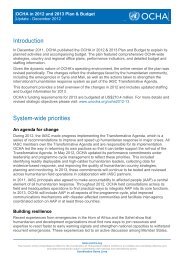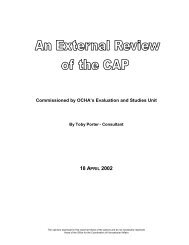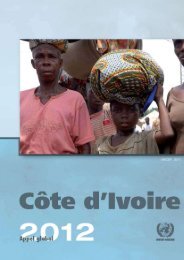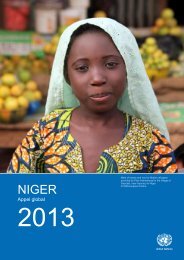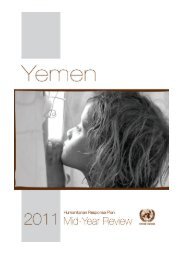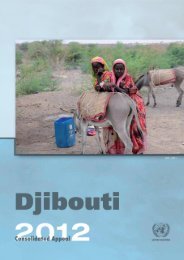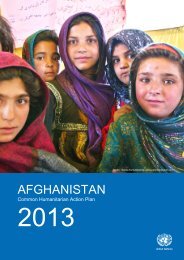DROUGHT
DROUGHT
DROUGHT
You also want an ePaper? Increase the reach of your titles
YUMPU automatically turns print PDFs into web optimized ePapers that Google loves.
1. EXECUTIVE SUMMARYLESOTHO <strong>DROUGHT</strong> FLASH APPEALA combination of extremely high temperatures and low rainfall has led to one of the worst droughts inthirty years, causing the Government to declare an emergency on 9 July and request internationalassistance. Maize production, the country’s main staple, has dropped by 51% compared to last year,causing a deficit that is likely to be further aggravated by decreased cereal production in parts ofSouth Africa, which has also experienced below-average rainfall for much of this year, and whichsupplies approximately 70% of Lesotho’s food requirements. As a result of reduced crop productionand limited casual labour opportunities, coupled with an exceptionally high price of South Africanmaize, international agencies estimate that up to 553,000 people will not be able to meet their annualfood needs, with many households having already exhausted their coping mechanisms.The drought will further worsen the already precarious situation of acute poverty and food security inLesotho. The most vulnerable have depleted their food reserves and due to rising prices are not ableto replenish them. The lack of employment opportunities will create a surplus of people looking forunskilled jobs, thus driving wages down. Wasting in children under five has surpassed theinternational threshold of 5% for declaring a situation of concern, reaching 6% this year from 2.4% in2006. An estimated 30% of boreholes and wells for potable water have dried up, as have many smalldam reservoirs on which livestock and gardens depend.While the immediate concern is food assistance to food-insecure households, there is an urgent needto restore their productive capacity in order to facilitate prompt recovery. External assistance isurgently needed to allow poor households to resume their crop production activities for the upcoming2007/2008 agricultural season; if this is not provided by October 2007, the planting season will bemissed and food insecurity will extend another year. In this light, the Government’s National ActionPlan for Food Security includes measures to improve farm productivity, income and household foodsecurity through intensification, diversification and commercialisation of farming systems andpromoting marketable sales of agricultural produce. It also aims to improve the nutritional and healthstatus of the most vulnerable, particularly those living with HIV and impacted by the AIDS epidemic.The international community is working in close cooperation with the Government of Lesotho toensure the necessary linkages between the emergency and recovery programming to ensure the foodsecurity of vulnerable households in the long term.As part of its own national emergency response, the Government has allocated US$ 1 19 million, ofwhich $12 million to large cash-for-work projects through land reclamation, and $6 million toagricultural activities. Government plans for the provision of a general subsidy for maize meal arealmost finalised. Additional humanitarian assistance, both national and international, is greatly neededto take the most vulnerable through to the next harvest expected in late May 2008.Within the framework of the flash appeal, the international community has identified key priority needsto be covered in the following sectors: agriculture, early recovery, food, health, nutrition, protection,and water and sanitation. The requirements of this flash appeal, which has a planning and budgetinghorizon of six months, amount to $18.9 million (following CERF commitments of $3.8 million), whichshould allow those hardest hit by the drought to recover and regain their resilience.Some basic facts about LesothoPopulation 1,872,000 people (GoL Census 2006)Under 5 mortality 132 p/1,000 (UNICEF 2005)Life expectancy 35.2 years (UNDP HDR 2006)Prevalence of undernourishment in total populationGross national income per capita13% (FAO Statistical Division 2004 estimate)USD 950 (World Bank Key DevelopmentData & Statistics 2005)Percentage of population living on less than $1 per day 36.4% (UNDP HDR 2006)‣ Proportion of population without sustainable access to an 21% (UNDP HDR 2006)improved drinking water source‣ ECHO Vulnerability and Crisis Index score (V/C) 2/3 (moderately severe / severe rank)‣ 2006 UNDP Human Development Index score 0.494: 149 th of 177 – lowAlso: ‣ HIV prevalence among 15-49 years is 23.2%. The number of adults living with HIV is 270,000;there are 23,000 deaths annually due to AIDS (UNDP HDR 2006).1All dollar figures in this document are United States dollars. Funding for this appeal should be reported to the Financial Tracking Service(FTS, fts@reliefweb.int), which will display its requirements and funding on the CAP 2007 page.1




